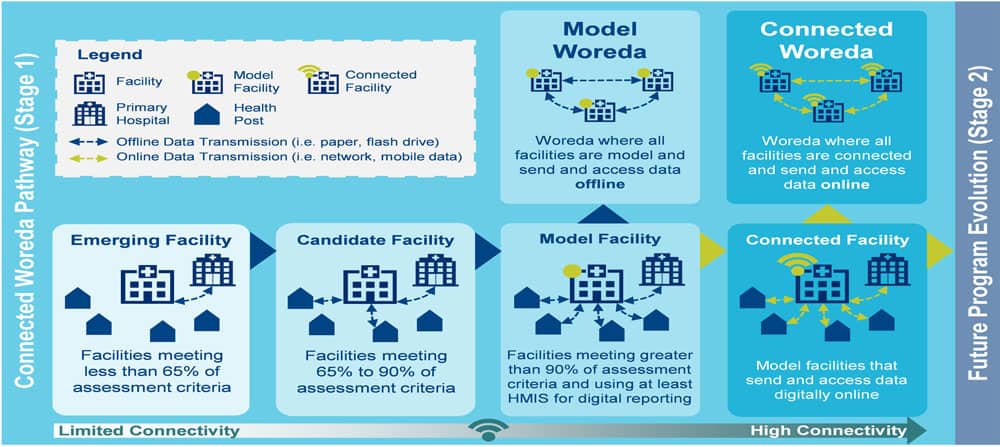Connected Woreda Program: A Conduit to the Health Information Revolution in Ethiopia
March 13th, 2018 | news
In Ethiopia, the health sector is undergoing a sea-change—organizationally, behaviorally, and technologically. The transformation is being driven by the goal of ensuring quality and equity of health care services and universal coverage. The Federal Ministry of Health (FMoH), the highest administrative body of the country’s health sector, has devoted its resources to bring about this change.
The FMoH developed the Health Sector Transformation Plan (HSTP), a 5-year strategic plan (2015/16–2020/21), to guide and accelerate the transition. One of the vehicles that will ensure the success of this transformation is the Information Revolution (IR) Roadmap, which aims to improve the use of information for decision-making at all levels of the health system by establishing an information culture and digitalizing the health information system (HIS).
A Conduit of Change
One way of translating the IR’s conceptual framework into operational, measurable goals is through the Connected Woreda Program, which focuses on the lower levels of the health system. The program takes an innovative approach where interventions, such as supporting and monitoring the woredas, or districts, will simultaneously transform the woreda into data nodes. The goal of the program—to enable health facilities to generate and use quality data through the electronic HIS—also ensures that the woredas have access to and can share data with all levels of the health administration and service points. A Connected Woreda, which the program derives its name from, is achieved when health facilities have attained better data quality and use practices and progressed through the following well-defined levels:

The grading of a facility is based on the scores it receives every six months after being evaluated on criteria that include M&E infrastructure, data quality, administrative, and clinic data use. The Woreda Health Office and Zonal Health Desk conduct the evaluation and it is verified by the Regional Health Bureau and FMoH.
In response to funding needs, and to build the capacity of the health system to implement the strategy, the FMoH has engaged local universities and partners, such as the JSI-led Data Use Partnership (DUP).
The Brick by Brick Approach
The Connected Woreda Program stipulates that the health data transformation should start at the health facility level, expand to the woreda, and then advance into the overall health system. For example, a woreda in which each facility is classified as a ‘Model facility’ is accredited as ‘Model Woreda’—which means it’s accessing and sending health data at least offline. If each of the facilities in the woreda is a ‘Connected facility,’ the woreda is classified as a ‘Connected Woreda’—which shows it is not only producing and using quality health data but also accessing and sharing the data online.
Using a brick by brick approach, the Connected Woreda Program creates a chain of networks from the lowest to the highest levels of the health system. When all the woredas in a zone are classified as ‘Connected,’ it results in a ‘Connected Zone.’ A region where all the zones are ‘Connected’ is a ‘Connected Region.’ Ultimately, the web of connections will create a network that is linked to regional and national HIS, which is why the program is an ideal conduit to realize the health information revolution across the country’s regions.
Empowering Community Health
The Connected Woreda Program is unique in that its bottom-up approach provides an opportunity for the local health community to contribute to and influence top-level decisions, such as formulating policies. It also helps communities gain experience and skills through supportive supervision and the creation of performance review teams, which are essential to sustaining achievements and further developing the program.
To accommodate future changes, the program is being implemented in two stages. The first stage ranges from setting-up to establishing the program. During this period, there will be a focus on strengthening M&E systems, operationalizing data quality and use practices, and using tools that support both online and offline data sharing. The second stage will incorporate the lessons learned in the first stage, ensure the sustainability of the initial stage’s accomplishments, and develop the program to keep up with ever-changing demands and technologies.
To promote the program, the FMoH, in collaboration with the DUP, organized a consultative workshop on January 24–27, 2018 in Adama to discuss the implementation strategy. With more than 50 participants from the FMoH, regional health bureaus, universities, and partner organizations, including USAID and JSI, the workshop solicited input to enrich the strategy. After incorporating participants’ feedback, the plan is to cascade and implement the strategy with technical and financial support from the DUP.
——
The Ethiopia Data Use Partnership (DUP) is a collaborative endeavor of the FMOH to advance the country’s healthcare. The DUP is a dynamic, responsive team of partners that is led by JSI and currently includes Regenstrief Institute, University of Gondar, and the Gobee Group. The DUP aims to improve the collection and use of high-quality routine information in the health sector, leading to better quality, efficiency, and availability of primary health and nutrition services at all levels of the health system. The DUP is funded by the Bill & Melinda Gates Foundation.
We strive to build lasting relationships to produce better health outcomes for all.